Effect of Ultrasonic Vibration Assistance on Microstructure Evolution and Mechanical Properties in Laser-Welded AZ31B Magnesium Alloy
Abstract
:1. Introduction
2. Experimental Procedures
2.1. Materials and Welding Equipment
2.2. Testing Equipment
3. Results and Discussion
3.1. Macrostructural Analysis
3.2. Microstructure Evolution Analysis
3.2.1. Metallographic Analysis
3.2.2. Phase Analysis
3.2.3. EBSD Analysis
3.3. Mechanical Property Analysis
3.3.1. Microhardness Analysis
3.3.2. Tensile Properties Analysis
4. Conclusions
Author Contributions
Funding
Institutional Review Board Statement
Informed Consent Statement
Data Availability Statement
Conflicts of Interest
References
- Song, J.; She, J.; Chen, D.; Pan, F. Latest research advances on magnesium and magnesium alloys worldwide. J. Magnes. Alloys 2020, 8, 1–41. [Google Scholar] [CrossRef]
- Yang, Y.; Xiong, X.; Chen, J.; Peng, X.; Chen, D.; Pan, F. Research advances in magnesium and magnesium alloys worldwide in 2020. J. Magnes. Alloys 2021, 9, 705–747. [Google Scholar] [CrossRef]
- Song, J.; Chen, J.; Xiong, X.; Peng, X.; Chen, D.; Pan, F. Research advances of magnesium and magnesium alloys worldwide in 2021. J. Magnes. Alloys 2022, 10, 863–898. [Google Scholar] [CrossRef]
- Qiao, Y.X.; Zheng, Z.B.; Yang, H.K.; Long, J.; Han, P.X. Recent progress in microstructural evolution, mechanical and corrosion properties of medium-Mn steel. J. Iron Steel Res. Int. 2023, 30, 1463–1476. [Google Scholar] [CrossRef]
- Sheng, S.L.; Qiao, Y.X.; Zhai, R.Z.; Sun, M.Y.; Xu, B. Processing map and dynamic recrystallization behaviours of 316LN-Mn austenitic stainless steel. Int. J. Miner. Metall. Mater. 2023, 30, 2386–2396. [Google Scholar] [CrossRef]
- Tan, J.; Ramakrishna, S. Applications of Magnesium and Its Alloys: A Review. Appl. Sci. 2021, 11, 6861. [Google Scholar] [CrossRef]
- Seetharaman, S.; Jayalakshmi, S.; Arvind Singh, R.; Gupta, M. The Potential of Magnesium-Based Materials for Engineering and Biomedical Applications. J. Indian Inst. Sci. 2022, 102, 421–437. [Google Scholar] [CrossRef]
- Prasad, S.V.S.; Prasad, S.B.; Verma, K.; Mishra, R.K.; Kumar, V.; Singh, S. The role and significance of Magnesium in modern day research-A review. J. Magnes. Alloys 2022, 10, 1–61. [Google Scholar] [CrossRef]
- Ramalingam, V.V.; Ramasamy, P.; Kovukkal, M.D.; Myilsamy, G. Research and development in magnesium alloys for industrial and biomedical applications: A review. Met. Mater. Int. 2019, 26, 409–430. [Google Scholar] [CrossRef]
- Zhao, J.; Wu, C.; Shi, L. Effect of ultrasonic field on microstructure evolution in friction stir welding of dissimilar Al/Mg alloys. J. Mater. Res. Technol. 2022, 17, 1–21. [Google Scholar] [CrossRef]
- Subravel, V.; Padmanaban, G.; Balasubramanian, V. Effect of welding speed on microstructural characteristics and tensile properties of GTA welded AZ31B magnesium alloy. Trans. Nonferrous Met. Soc. China 2014, 24, 2776–2784. [Google Scholar] [CrossRef]
- Chen, J.Q.; Li, F.; Wu, Z.G.; Lyu, W.G. Effect of heat input on the microstructure and mechanical properties of an electron-beam-welded AZ31 magnesium alloy. Mater. Tehnol. 2020, 54, 819–828. [Google Scholar] [CrossRef]
- Xu, Y.L.; Qian, P.; Qiao, Y.X.; Li, J.Y.; Zhang, J.S. Study on laser welding process, microstructure and properties of AZ31B magnesium alloy. Trans. Indian Inst. Met. 2022, 75, 2905–2912. [Google Scholar] [CrossRef]
- Yang, F.; Liu, B. The effects of ultrasonic vibration on microstructural changes and mechanical properties of Mg alloy joint. Mater. Res. Express 2021, 8, 026512. [Google Scholar] [CrossRef]
- Min, D.; Shen, J.; Lai, S.; Chen, J.; Xu, N.; Liu, H. Effects of heat input on the low power Nd:YAG pulse laser conduction weldability of magnesium alloy AZ61. Opt. Lasers Eng. 2011, 49, 89–96. [Google Scholar] [CrossRef]
- Xu, Y.L.; Qian, P.; Li, J.Y.; Qiao, Y.X.; Zhang, J.S.; Liu, J. Effect of solution and aging treatment on microstructure and properties of AZ31B magnesium alloy laser welded joint. Phys. Met. Metallogr. 2023, 123, 1491–1498. [Google Scholar] [CrossRef]
- Xu, Y.L.; Qian, P.; Qiao, Y.X.; Yin, W.J.; Jiang, Z.W.; Li, J.Y. The influence of heat and cryogenic treatment on microstructure evolution and mechanical properties of laser-welded AZ31B. Materials 2023, 16, 4764. [Google Scholar] [CrossRef]
- Li, C.; Zhang, X.; Wang, J. The effect of axial external magnetic field on tungsten inert gas welding of magnesium alloy. Mater. Res. Express 2018, 5, 046531. [Google Scholar] [CrossRef]
- Yuan, T.; Kou, S.; Luo, Z. Grain refining by ultrasonic stirring of the weld pool. Acta Mater. 2016, 106, 144–154. [Google Scholar] [CrossRef]
- Yang, F.; Zhou, J.; Ding, R. Ultrasonic vibration assisted tungsten inert gas welding of dissimilar magnesium alloys. J. Mater. Sci. Technol. 2018, 34, 2240–2245. [Google Scholar] [CrossRef]
- Xu, C.; Yuan, X. Effect of ultrasonic field parameters on interfacial characteristics and mechanical properties of Mg alloy welding joint. Mater. Lett. 2022, 306, 130962. [Google Scholar] [CrossRef]
- Lei, Z.; Bi, J.; Li, P.; Li, Q.; Chen, Y.; Zhang, D. Melt flow and grain refining in ultrasonic vibration assisted laser welding process of AZ31B magnesium alloy. Opt. Laser Technol. 2018, 108, 409–417. [Google Scholar] [CrossRef]
- Baradarani, F.; Mostafapour, A.; Shalvandi, M. Effect of ultrasonic assisted friction stir welding on microstructure and mechanical properties of AZ91−C magnesium alloy. Trans. Nonferrous Met. Soc. China 2019, 29, 2514–2522. [Google Scholar] [CrossRef]
- Min, D.; Shen, J.; Lai, S.; Chen, J. Effect of heat input on the microstructure and mechanical properties of tungsten inert gas arc butt-welded AZ61 magnesium alloy plates. Mater. Charact. 2009, 60, 1583–1590. [Google Scholar] [CrossRef]
- Ramirez, A.; Qian, M.; Davis, B.; Wilks, T.; StJohn, D.H. Potency of high-intensity ultrasonic treatment for grain refinement of magnesium alloys. Scr. Mater. 2008, 59, 19–22. [Google Scholar] [CrossRef]
- Xu, C.; Sheng, G.; Cao, X.; Yuan, X. Evolution of Microstructure, Mechanical Properties and Corrosion Resistance of Ultrasonic Assisted Welded-Brazed Mg/Ti Joint. J. Mater. Sci. Technol. 2016, 32, 1253–1259. [Google Scholar] [CrossRef]
- Lei, Z.; Bi, J.; Li, P.; Guo, T.; Zhao, Y.; Zhang, D. Analysis on welding characteristics of ultrasonic assisted laser welding of AZ31B magnesium alloy. Opt. Laser Technol. 2018, 105, 15–22. [Google Scholar] [CrossRef]
- Coelho, R.S.; Kostka, A.; Pinto, H.; Riekehr, S.; Koçak, M.; Pyzalla, A.R. Microstructure and mechanical properties of magnesium alloy AZ31B laser beam welds. Mater. Sci. Eng. A 2008, 485, 20–30. [Google Scholar] [CrossRef]
- Wen, T.; Liu, S.-y.; Chen, S.; Liu, L.-t.; Yang, C. Influence of high frequency vibration on microstructure and mechanical properties of TIG welding joints of AZ31 magnesium alloy. Trans. Nonferrous Met. Soc. China 2015, 25, 397–404. [Google Scholar] [CrossRef]
- Alavi, S.H.; Harimkar, S.P. Melt expulsion during ultrasonic vibration-assisted laser surface processing of austenitic stainless steel. Ultrasonics 2015, 59, 21–30. [Google Scholar] [CrossRef]



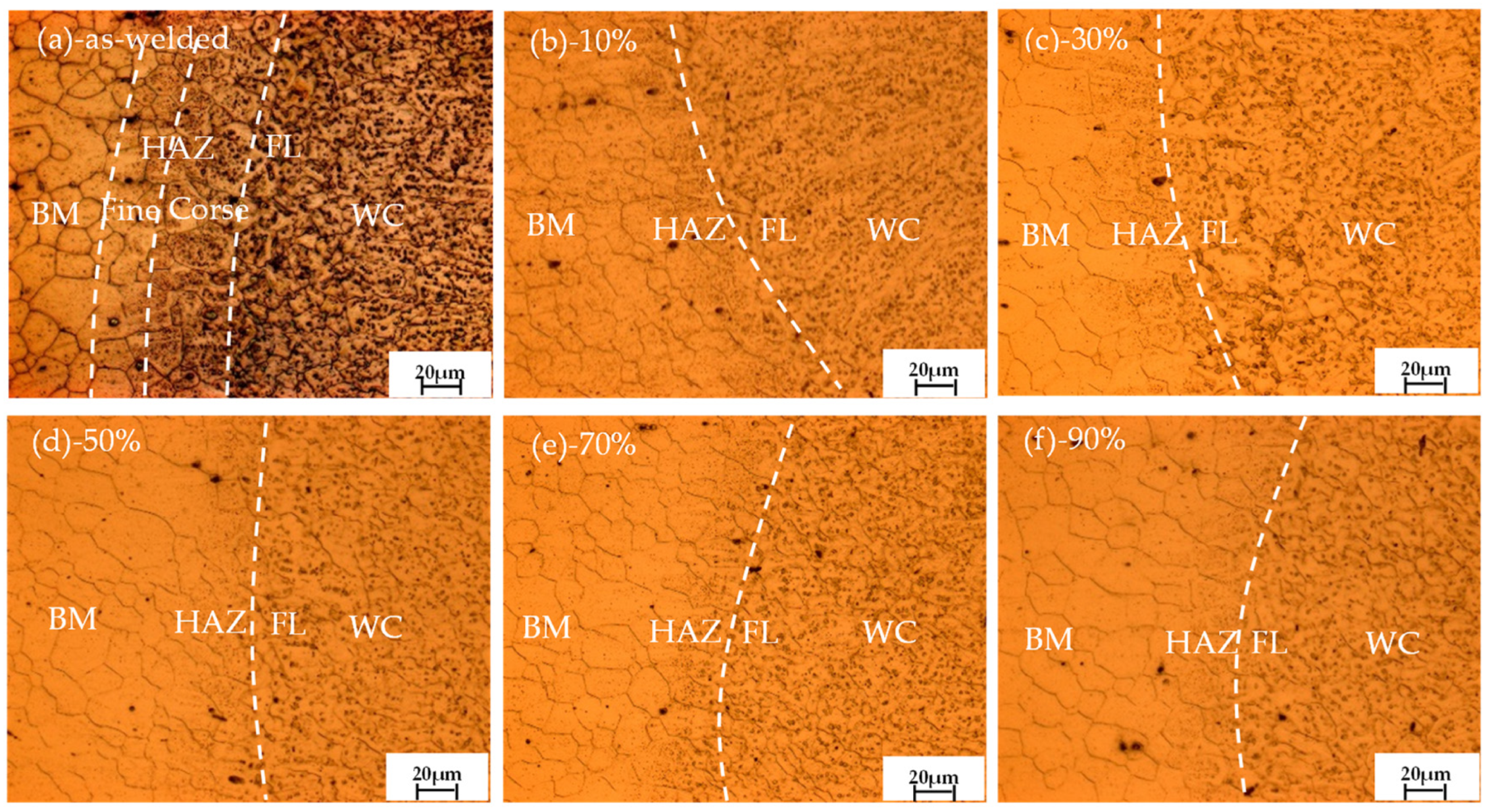
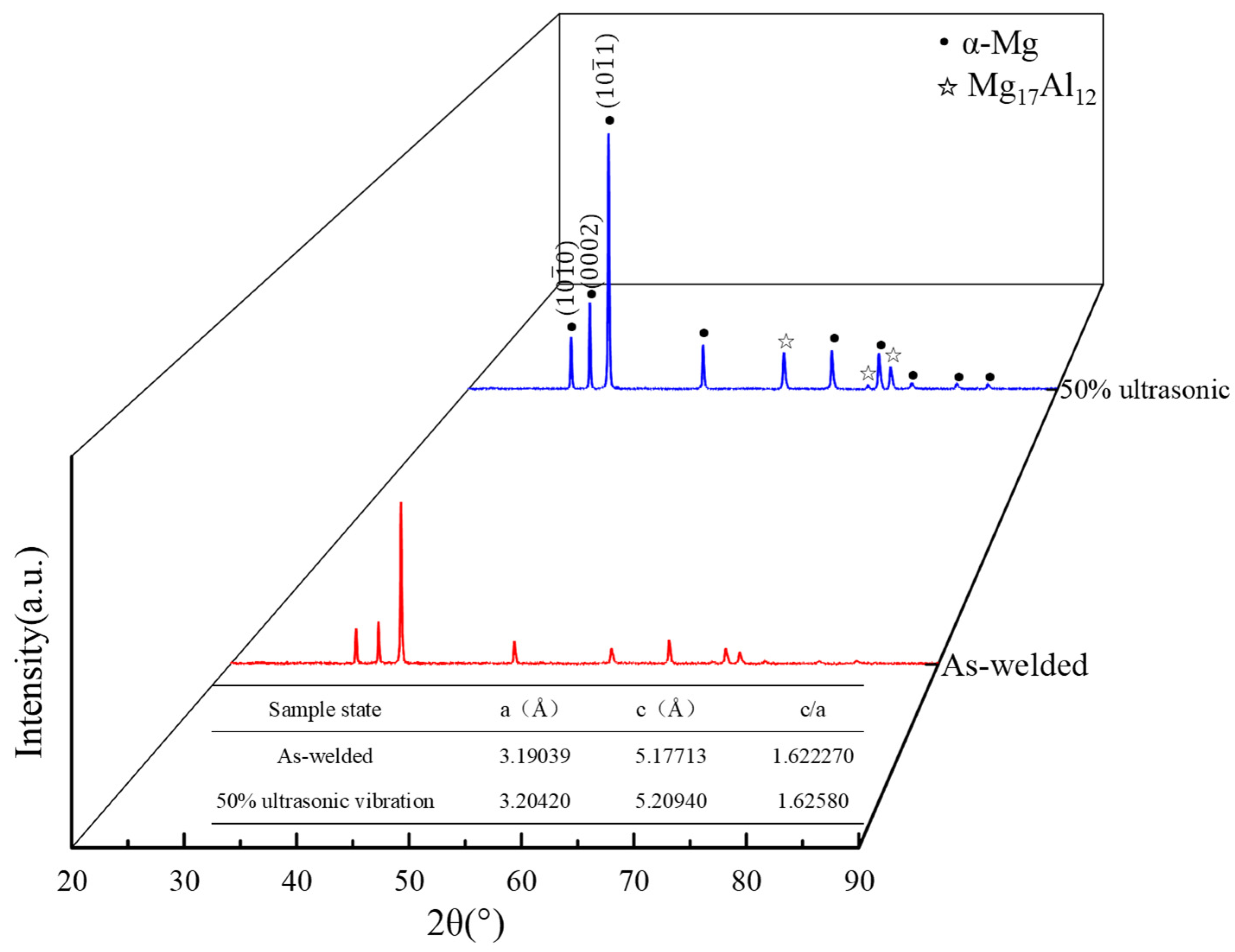
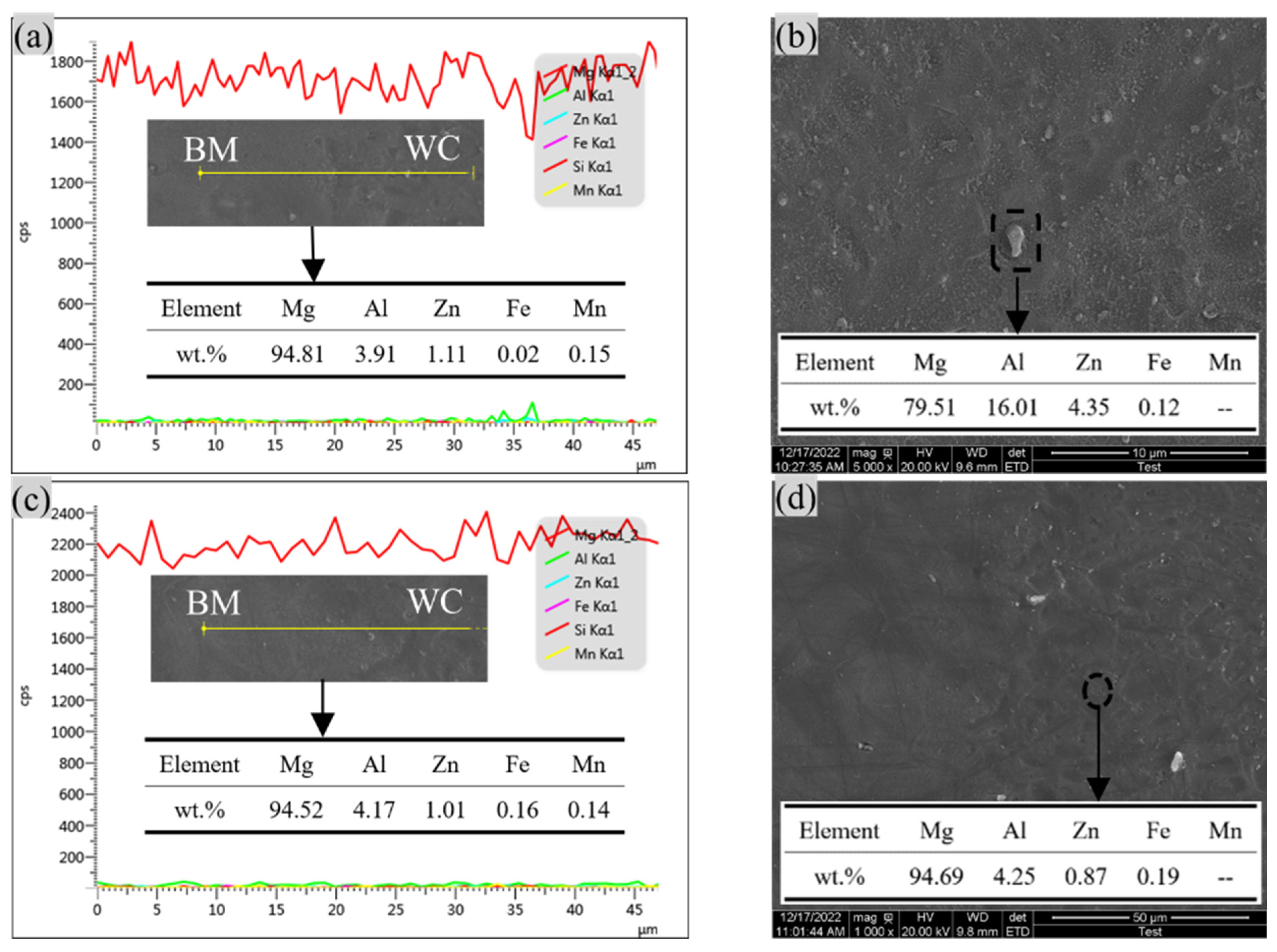
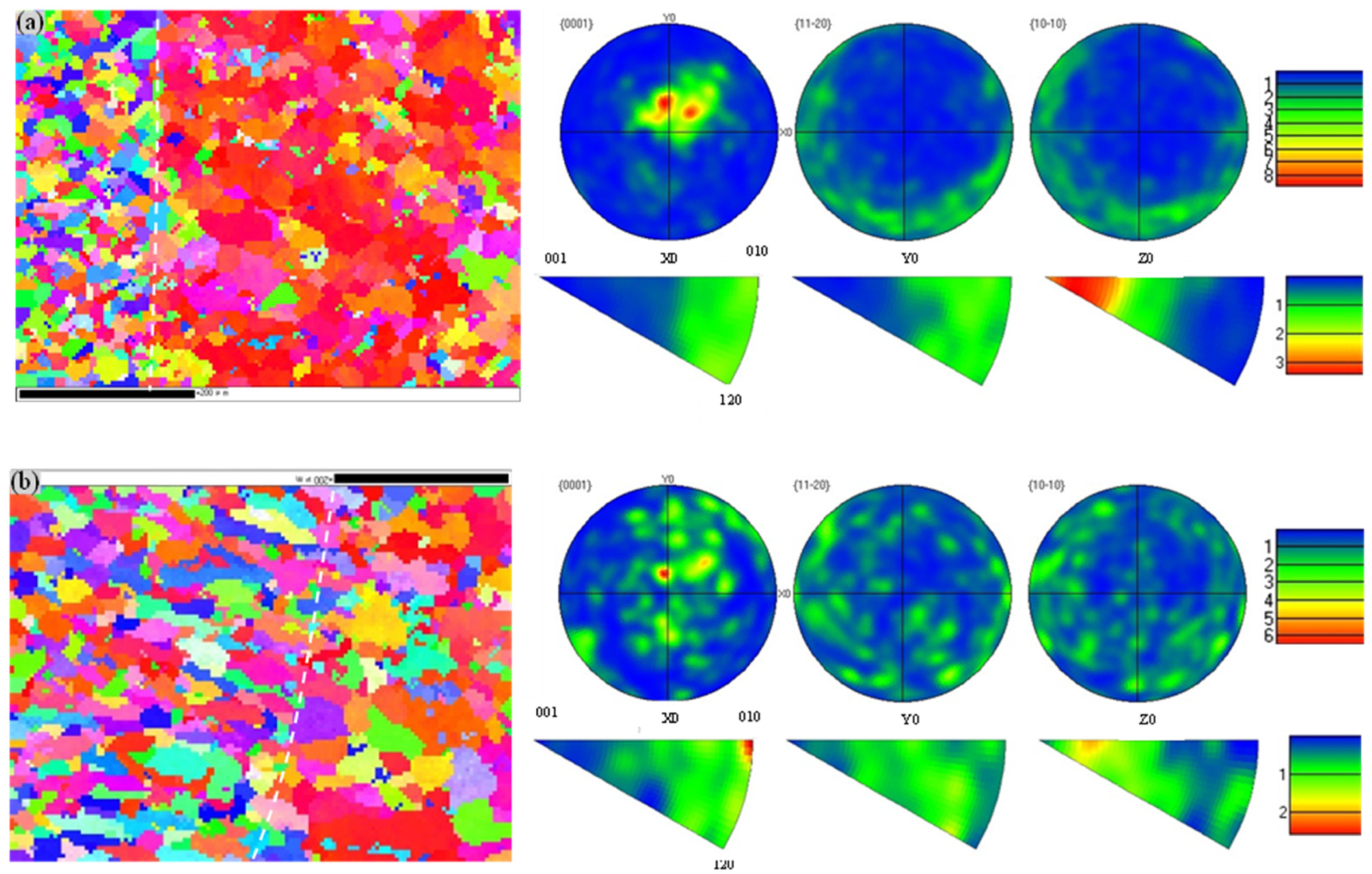
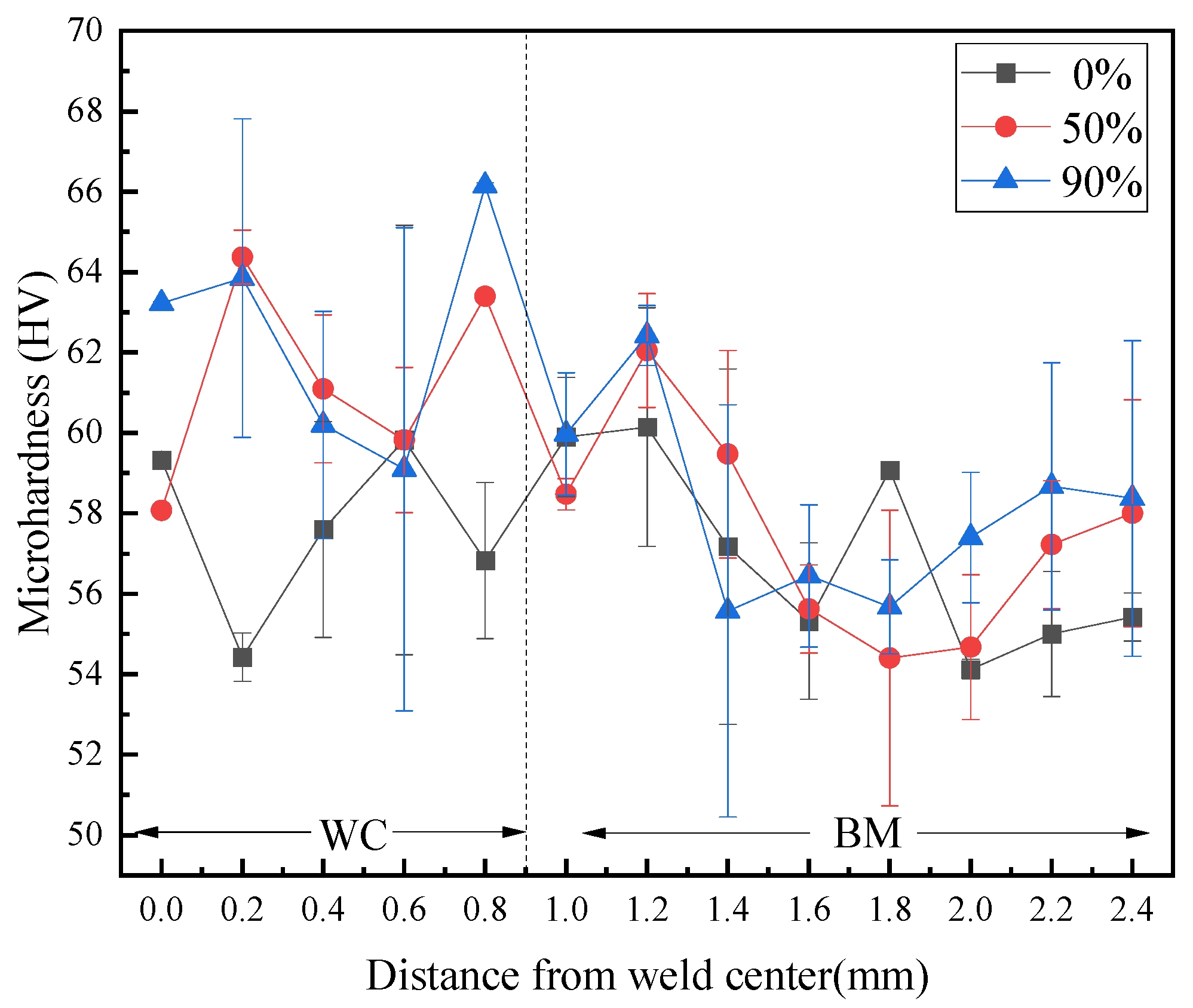
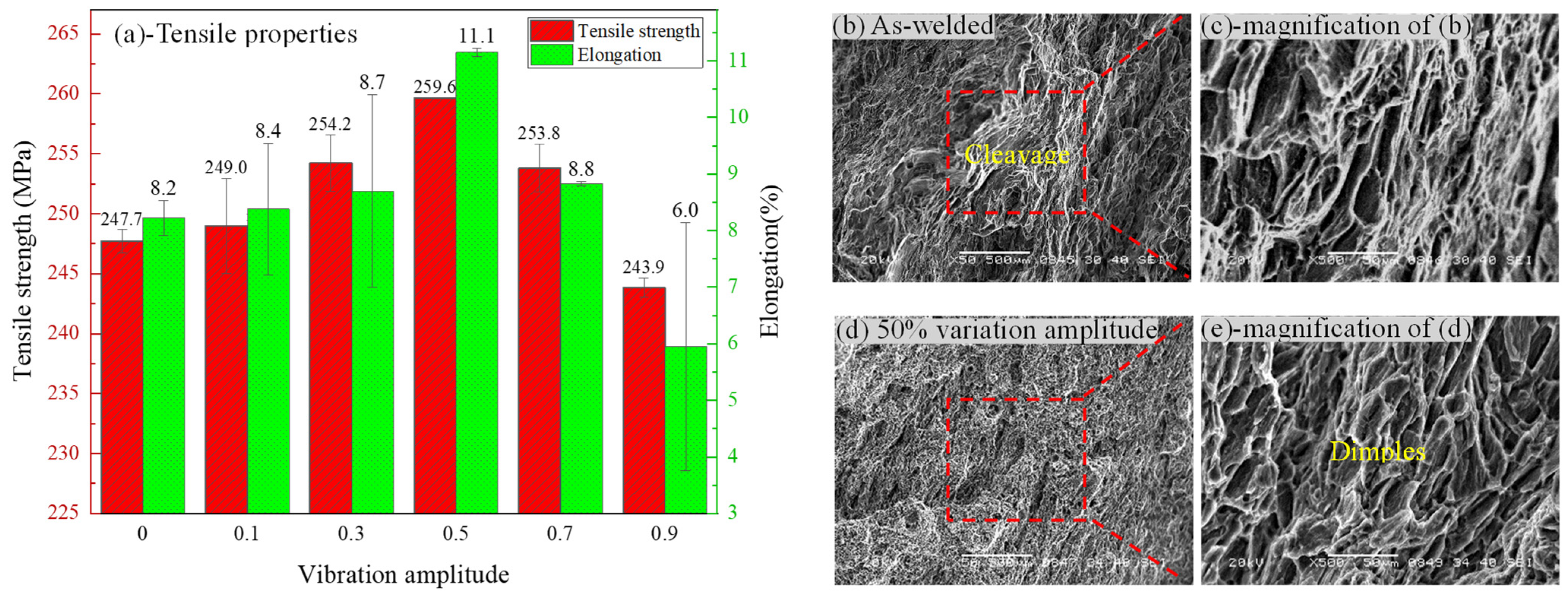
| Proportion of max vibration amplitude | 10% | 30% | 50% | 70% | 90% |
| Vibration offset (μm) | 0 | 1.6 | 4.8 | 8 | 14.4 |
Disclaimer/Publisher’s Note: The statements, opinions and data contained in all publications are solely those of the individual author(s) and contributor(s) and not of MDPI and/or the editor(s). MDPI and/or the editor(s) disclaim responsibility for any injury to people or property resulting from any ideas, methods, instructions or products referred to in the content. |
© 2023 by the authors. Licensee MDPI, Basel, Switzerland. This article is an open access article distributed under the terms and conditions of the Creative Commons Attribution (CC BY) license (https://creativecommons.org/licenses/by/4.0/).
Share and Cite
Xu, Y.; Li, J.; Qiao, Y.; Wang, W.; Lan, X.; Guo, X. Effect of Ultrasonic Vibration Assistance on Microstructure Evolution and Mechanical Properties in Laser-Welded AZ31B Magnesium Alloy. Metals 2024, 14, 35. https://doi.org/10.3390/met14010035
Xu Y, Li J, Qiao Y, Wang W, Lan X, Guo X. Effect of Ultrasonic Vibration Assistance on Microstructure Evolution and Mechanical Properties in Laser-Welded AZ31B Magnesium Alloy. Metals. 2024; 14(1):35. https://doi.org/10.3390/met14010035
Chicago/Turabian StyleXu, Yulang, Jingyong Li, Yanxin Qiao, Weidong Wang, Xuzhi Lan, and Xuyang Guo. 2024. "Effect of Ultrasonic Vibration Assistance on Microstructure Evolution and Mechanical Properties in Laser-Welded AZ31B Magnesium Alloy" Metals 14, no. 1: 35. https://doi.org/10.3390/met14010035
APA StyleXu, Y., Li, J., Qiao, Y., Wang, W., Lan, X., & Guo, X. (2024). Effect of Ultrasonic Vibration Assistance on Microstructure Evolution and Mechanical Properties in Laser-Welded AZ31B Magnesium Alloy. Metals, 14(1), 35. https://doi.org/10.3390/met14010035







